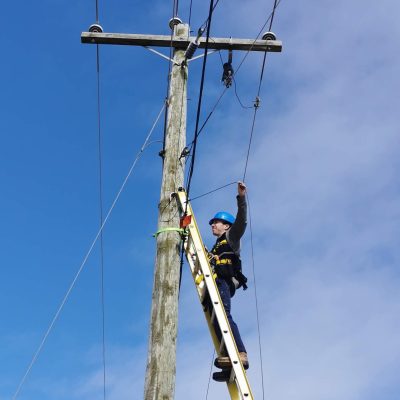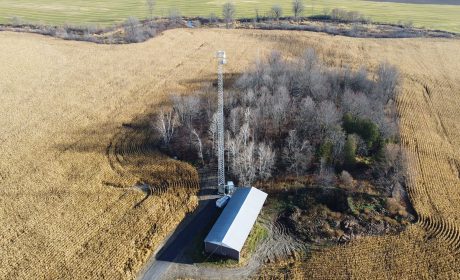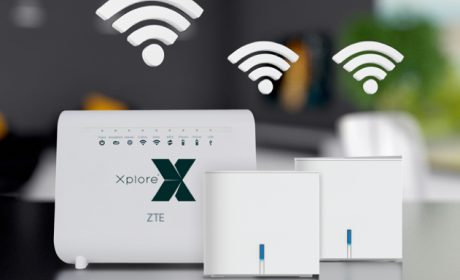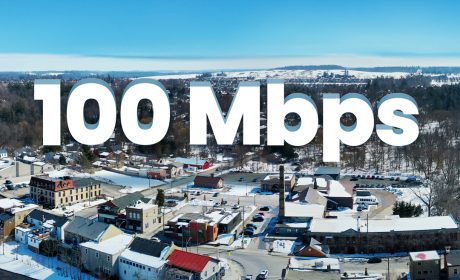What’s the deal with fibre?
You've probably heard someone in your circle talking about fibre. Fibre is the fastest way to get Internet delivered to your home, cottage or business today.


In September 2022 Xplornet became Xplore. Read more here.
How does fibre to the home work?
Fibre harnesses the speed of light to transmit data over very long distances. We’re able to take electronic bits, bytes and data and transmit them via light through cables and then reconvert that light to data that is used by our electronic devices.
How is fibre-to-the-home installed?
The main fibre optic line typically runs along the hydro lines in your community or it’s buried underground.
The fibre line is then connected to what is commonly called a “flower pot” or a “splitter” located somewhere in your neighborhood.
From there, the fibre is either buried on your property, or brought to your home by aerial installation.
It's then fed inside your home and connected to the “ONT” device which converts the fibre optic signal to data that communicates with your devices.
Will my lawn be damaged during installation?
Our local technicians take every step to ensure everything is left just the way we found it! For installs where the cable is run underground, the contractors either use a vibratory plough or a directional drill to place the fibre underground with minimal impact to the property. As determined by the local municipality, our remediation teams will repair disturbed earth with topsoil and grass seed or sod.
How fast is fibre?
Xplore offers packages with download and upload speeds up to 1 Gbps (plus, truly unlimited data). You’ll notice that fibre packages sometimes note “symmetrical speeds” – this means that the download and upload speeds are the same.
What can I do at home on a fibre Internet connection?
With fibre Internet connections, one of the biggest benefits is you can connect many more devices and have them in use all at the same time. As an example, a customer may have a connected home with multiple Wi-Fi security cameras, smart lighting throughout their home, plus 3 or 4 users on video conferences or streaming video. With fibre, this can all happen simultaneously without degradation in speed or quality.
How reliable is fibre?
Very reliable! Peak traffic over a cable or DSL Internet connection can overload the wires, slowing or interrupting your connection. Fibre optics can handle more users and more data and remain more consistent. And, if there are issues, our team and partners have the tools and know-how to remedy them quickly.
Are there any other benefits of installing fibre?
Once fibre is installed in your home, it becomes a permanent fixture of your home similar to electricity and water. You will always have the fastest Internet available to you once it’s installed and you have an active subscription. Fibre will continue to be the gold standard when it comes to residential Internet services for the foreseeable future so your connection is also future-proof.
What sets Xplore apart from competitors?
Xplore delivers a 100% pure fibre connection to your home unlike other providers that bring fibre to the neighbourhood or curb and then use older technology to deliver Internet to your home. 100% pure fibre means faster speeds, particularly for upload data traffic, and more reliable connectivity.
Where is fibre being built now?
Xplore has projects underway in Alberta, Manitoba, Ontario, Quebec, New Brunswick, Nova Scotia, and PEI. And we’re not stopping there – we’re investing $500 million by 2025 to bring fibre and fibre-powered Internet to more homes across rural Canada.
Where is fibre available now?
Xplore Fibre is already available in Alberta, Ontario, Quebec, Nova Scotia and PEI. And, to check if your home will be covered, visit our Fibre Internet Lookup.
Where can we expect fibre in the future?
We are continuing to invest in the expansion of our fibre network and are looking forward to announcing more service availability soon. Stay up to date by following us on Facebook, Twitter and Instagram and checking our Fibre Lookup page.
What if I can’t get fibre?
Customers who cannot get fibre directly to their home will still benefit from our investments in fibre as many of our LTE and upcoming 5G fixed wireless towers will be supported by our fibre network. Our fibre-powered fixed wireless network provide speeds up to 100 Mbps to customers outside our fibre network. This means that even if you cannot get fibre directly to your home, you will still benefit from fibre through our 5G and fixed wireless products. You can check what is available at your home with our Check Internet Options page.
What is the difference between fibre and LTE?
The key difference is fibre delivers data through a fibre optic connection directly to your home, where LTE delivers data wirelessly from a device installed to an LTE tower to a device installed at your home. That’s a long way to say the difference is a wired connection verses a wireless connection.


